Mattress Sizes

Whether it’s your first time buying a mattress, or it’s been awhile since you bought your last one, choosing a new mattress can be a big decision. You don’t want to spend a large chunk of change only to realize you didn’t make the right choice. Before you start to worry, we’re here to help.
We’ll break down all the mattress size terminology in this guide so you can choose the best mattress size for you, whether you’re sleeping alone or with a loved one (human or animal), or whether you like to cozy up or sprawl out.
Get started with a quick look at the chart below or scroll down for more details on each mattress size.
Mattress Size Guide
| Mattress Size | Dimensions | Comfortably Fits |
|---|---|---|
| Twin | 38” x 75” | 1 person |
| TwinXL | 38” x 80” | 1 person |
| Full/Double | 54” x 75” | 1 person with a pet, 2 adults, no pets |
| Queen | 60” x 80” | 1 person with a pet, 2 adults, no pets |
| King | 76” x 80” | 1 adult with pet(s) or child(s), 2 adults with a large pet or child |
| California King | 72” x 84” | 1 adult with multiple pets or children, 2 adults with multiple pets or children |
| Crib Mattress | 28” x 52” | 1 baby |
| Toddler Mattress | 28” x 52” | 1 toddler |
Twin Mattress
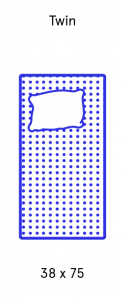
Twin Mattress Dimensions: 38” x 75”
The twin mattress size is the smallest mattress size that can accommodate young children and most adults comfortably.
Great for… children, single adults, anyone with a small living situation such as a studio apartment or shared room.
Not so great for… couples, taller adult men and women, anyone who likes to spread out when they sleep. Keep in mind that 75 inches translates to 6 foot 3.
Twin XL Mattress
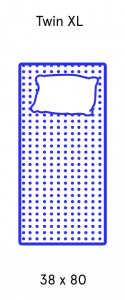
Twin XL Mattress Dimensions: 38” x 80”
The twin XL mattress is the mattress you’re most likely to spot in college dorm rooms. It fits in smaller living spaces while providing extra length for taller adults or teenagers.
Great for… taller adults or teenagers in a small living situation such as a studio apartment or shared room.
Not so great for… couples, anyone who likes to spread out when they sleep.
Full/Double Mattress
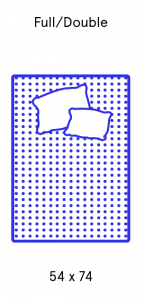
Full/Double Mattress Dimensions: 54” x 75”
The full mattress (also known as a double mattress) provides a little over a foot more width to the bed than twin or twin XL mattresses. It used to be the standard size for couples several decades ago when homes were built smaller, but now is more commonly used for individual adults or children who can afford to have the extra space to spread out.
Great for… individual children or adults sleeping alone or with a pet, couples who like to cozy up without pets.
Not so great for… couples where one or both persons wish to have a little personal space to spread out or stretch their legs, taller adults, couples who wish to sleep with their pets.
Queen Mattress
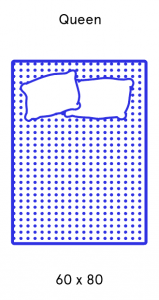
Queen Mattress Dimensions: 60” x 80”
The queen mattress is the most popular mattress size sold today. It provides the extra length for taller adults, and the extra width so couples can still snuggle up but enjoy their personal space to stretch a bit, too.
Great for… adults living on their own who prefer to spread out or sleep with their pets, couples who like to sleep near each other without pets, smaller master bedrooms.
Not so great for… couples where both people like to really spread out or who wish to sleep with their pets.
King Mattress
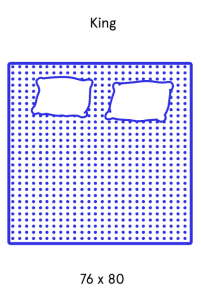
King Mattress Dimensions: 76” x 80”
The king mattress is the same size as two twin beds side by side. This offers couples ample room to spread out, or to sleep with a large pet or children. For couples who require different support or prefer different mattress types, you can order two different twin mattresses to fit the king bed frame.
Great for… couples who like to spread out, couples who like to sleep with large pets or children, larger master bedrooms (ideally 12 x 10 square feet).
Not so great for… couples with smaller master bedrooms.
California King Mattress
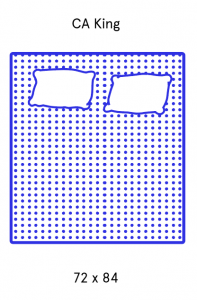
California King Mattress Dimensions: 72” x 84”
The California king mattress is the longest mattress size out there (unless you order a custom mattress, of course)! This is the couple-size version of the twin XL mattress – it provides extra inches for taller adults.
Great for… taller couples who like to spread out, couples who like to sleep with multiple large pets or children, larger master bedrooms.
Not so great for… couples with smaller master bedrooms.
Crib Mattress
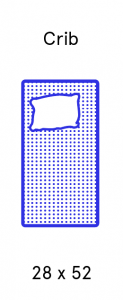
Crib Mattress Dimensions: 28” x 52”
Crib mattresses are designed for – you guessed it – cribs for newborns and babies. These are designed for crib frames and will last until your child meets one of the following conditions: is about 18 months old, reaches 3 feet in height, or begins escaping their crib. Search for as firm a mattress as possible. Young infants aren’t able to maneuver themselves so if the mattress is too soft and their face sinks in, they are at increased risk of SIDS or suffocation.
Great for… children up to 18 months old or less than 3 feet in height.
Not so great for… everyone else.
Toddler Mattress
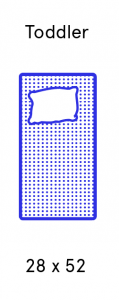
Toddler Mattress Dimensions: 28” x 52”
Toddler mattresses are typically the same size as a crib mattress. What’s different is that toddler mattresses are slightly softer, and are placed in toddler bed frames versus cribs. Parents can opt to buy detachable safety rails to protect the child from falling out. Some parents skip the toddler mattress altogether and move straight to a twin mattress after the crib.
Great for… toddlers or small children.
Not so great for… everyone else.
Mattress Size vs. Mattress Thickness
A common misconception is that larger-size mattresses are thicker than smaller-size mattresses. In fact, most mattress models sold today are the same thickness in each available size, even if the model is available in more than one thickness profile. For instance, let’s say a mattress model is available in 8″ and 10″ thickness options; both profiles will normally be sold in all sizes from Twin to California King.
Mattresses sold today may measure anywhere from six to 18 inches thick, but the vast majority are eight to 12 inches thick. When choosing a mattress based on thickness, your weight and your sleep partner’s weight are the most important considerations. Adult sleepers are divided into three general weight groups.
- Light (less than 130 pounds): Sleepers in this group typically prefer mattresses that are 10 inches thick or shorter. These beds offer adequate support for lighter individuals without sinking excessively. Most lighter people also have an easier time getting on and off shorter beds.
- Average (130 to 230 pounds): Those who are average weight may feel comfortable on any bed that measures eight to 12 inches thick, though most prefer those in the 10- to 12- inch range. This thickness offers a balance of conforming and support that is optimal for most average-weight sleepers.
- Heavy (more than 230 pounds): In most cases, sleepers weighing more than 230 pounds prefer beds that are at least 11 to 12 inches thick – and many may find that more than 12 inches is the best option. Thicker beds won’t sag as much beneath their bodies as thinner ones; additionally, heavier people may struggle getting on and off lower-profile beds.
One thing to note is that higher-profile mattresses tend to be priced higher than lower-profile beds. This is because thicker beds tend to contain more layers of padding and support material, including foams, latex, microcoils, and other potentially expensive components. So if you are mattress shopping on a budget, then a lower-profile bed may be the most suitable choice.
What Size Mattress Do I Need?
When choosing a mattress based on size, here are few important factors to take into account:
- Do you sleep alone or with a partner?
- What is your body type?
- Do children and/or pets frequently share your bed?
- How do you position your body when you sleep?
- How much bedroom space do you have?
- What is your mattress shopping budget?
- If shopping for a child's mattress, how old is your child?
Generally speaking, Twin, Twin XL, and Full mattresses are most suitable for single sleepers, while Queen, King, and California King mattresses are designed for two sleepers.
It’s important to remember that Queen sizes will provide less space between the two sleepers than a King or California King will. If you and your sleep partner prefer sleeping close to one another, then a Queen will most likely work. Otherwise, a King or California King will be a better option.
By the same token, Twin and Twin XL mattresses provide less width than Full mattresses. Single sleepers that don’t like sleeping close to the edge of their bed should opt for a Full, but if this is not an issue then Twin or Twin XL sizes will suffice.
Most single sleepers will find all mattress sizes provide adequate space for them, regardless of their height or weight. However, those with larger bodies should consider mattress width. A typical Twin/Twin XL mattress measures 38 to 39 inches wide, while a Full usually measures 53 to 54 inches wide. If these dimensions are too narrow, then consider a Queen or larger.
In terms of height, a typical Twin or Full mattress will accommodate anyone who is 6 feet 2 inches or shorter; a Twin XL, Queen, or King will accommodate anyone who is 6 feet 7 inches or shorter; and a California King will accommodate anyone who is 6 feet 11 inches or shorter. Those who are 7 feet or taller may want to consider a custom bed with longer length dimensions.
If one or more children frequently sleeps in bed with you, then a Queen size or larger is usually necessary – even if you are a single sleeper and don’t have an adult sleep partner. A Full may be wide enough to accommodate you and a smaller child, but not older children and/or more than one child. If you share your bed with another adult and children visit during the night, then a King or California King will usually work best.
If you share your bed with a larger dog, then a Queen or larger may be needed – even if you don’t have an adult sleep partner. However, Twin, Twin XL, and Full mattresses may be large enough to accommodate you and a smaller dog, cat, and other smaller pets.
Do you like to sprawl out your arms and legs while you sleep? If so, then a Queen, King, or California King will be the best option – especially if you have a sleep partner. Single sleepers who tend to tuck in their arms and legs during the night may find that smaller mattress sizes are sufficient. Those who toss and turn may find smaller sizes too narrow.
Larger mattress sizes take up a lot of space. It’s important to measure the available square footage in your bedroom before choosing a mattress size. Standard square inches/footage measurements for common mattress sizes are as follows:
- Twin: 2,925 sq. in./20.3 sq. ft.
- Twin XL: 3,120 sq. in./21.7 sq. ft.
- Full: 4,050 sq. in./28.1 sq. ft.
- Queen: 4,800 sq. in./33.3 sq. ft.
- King: 6,080 sq. in./42.2 sq. ft.
- California King: 6,048 sq. in./42 sq. ft.
Also be sure to take the mattress height into consideration, particularly if you have low ceilings or fixtures, or you want to store items underneath the bed.
The cost difference between a Twin and a King/California King can be slight or significant, depending on the brand. Be sure to draw comparisons between the price-points of different brands while you are shopping. Also, keep in mind that Twin/Twin XL and King/California King mattresses often share the same model-specific price-points.
Crib mattresses are designed for newborns and infants up to 18 months old, as well as those whose height measures three feet or shorter. If your child is older and/or taller, then a Toddler mattress will be the most suitable option.
Mattress Size FAQ
Still have questions? The FAQ section below seeks to answer the most common questions we have received about mattresses.
Can two people sleep in a full bed?
It is not uncommon for a couple to share a full-size mattress. However, whether two people can fit comfortably on a full-size mattress may depend on the size of each individual and/or their personal sleep needs. To give you some perspective, each person will have around 27 inches of space when sharing a full bed.
What’s the difference between a full and a double?
In the mattress world, the terms “full” and “double” are often used interchangeably. “Double” is a slightly older term that is not as commonly used. It’s worth noting that a full and double are both shorter than a queen; you may want to take height into consideration when deciding between a full or queen.
What’s the difference between a twin and a single?
Much like single and double, a “twin” and a “single” are terms used interchangeably in the mattress industry, with “single” being the slightly older term.
Can you get a custom sized mattress?
The most common sizes, “king”, “queen”, “full”, and “twin” are not the only mattresses available for purchase. Many companies will make a custom mattress upon request. For example, some manufacturers will special-design an extremely tall mattress or a mattress that is larger than a California king.
Are there different sized mattresses for RVs?
Because recreational vehicles (RVs) typically feature a smaller space for sleeping, RV mattresses usually have a smaller size and lower profile. If you are searching for an RV mattress, you generally have the option to purchase a mattress that has been specially designed for an RV or a low-profile, small-size bed.
Are there any sizes larger than a California King?
Mattresses larger than the California King do exist, and are sometimes referred to as “Alaska King” or “Wyoming King” beds. The Alaska King measures at a whopping 9’ by 9’, while the Wyoming King is a slightly smaller 7’ by 7’. By comparison, California Kings measure 72” x 84”.
Alaska and Wyoming mattresses are ideal for young families who prefer to sleep together, people who share beds with large dogs, and people who simply want more space when sleeping with their significant other. You won’t find Alaska or Wyoming King beds in most retail stores; these beds typically require custom design requests.
What’s the most popular mattress size?
Capable of fitting two people comfortably, “queen” is the most popular mattress size.
Do I need sheets and a comforter that are the same size as my bed?
The short answer is yes. Particularly when it comes to fitted sheets, it is important to purchase sheets that are not only the correct size, but have the correct depth or height.The general rule of thumb is that you need a fitted sheet depth that is at least two inches deeper than the height of your mattress.
On the other hand, if you choose a mattress comforter or duvet that is slightly too large for your bed, it’s often less of a problem — the ends of the bedding may simply hang off the sides of the mattress.
Are there different sized pillows as well?
Pillow size may come into play depending on the size of your mattress. The smallest and most common sized pillows, standard (20W” x 26L”), tend to be sufficient for twin and full-size mattresses. However, people who toss and turn frequently during the night may opt for a larger pillow — such as the super standard (20W” x 28L”), queen (20W” x 30L”), or king (20-21W” x 36-41?L). You may also consider a body pillow (dimensions vary; generally between 48W” x 20L” or 54W” x 24L”), ideal for side sleepers, pregnant women, and those who enjoy snuggling with their pillow.